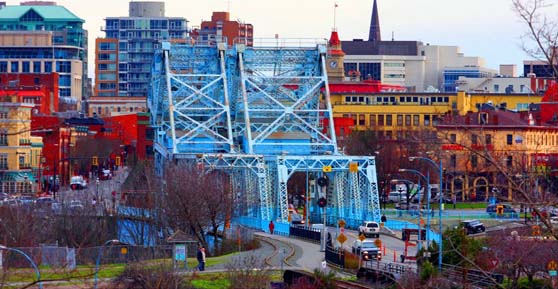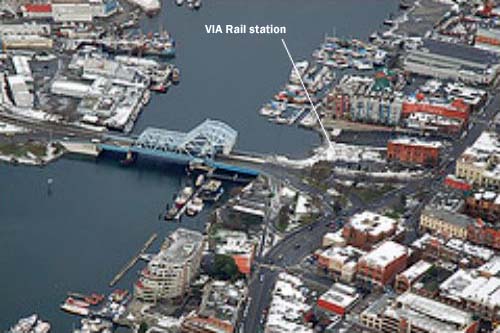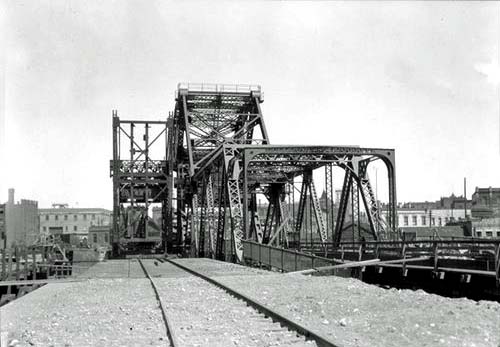
31 July 2010
What's Best for the Blue Bridge?

The Victoria Blue Bridge.

Victoria Vancouver Island British Columbia - The answer seems like a no-brainer.
You can spend $77 million and build a shiny new Johnson Street Bridge, complete with a really cool circular counterweight you could stand in while the bridge
is raised and lowered, on-street bike lanes, a dedicated sidewalk, a separate multi-use trail, improved road approaches, and a wider navigation channel for
boats. There'd be virtually no disruption of traffic during construction, the span would last 100 years, and it could withstand an earthquake up to magnitude
8.5.

Arial view of the Blue Bridge.
Or you can spend $3 million more and get less, a lot less.
For $80 million, the existing bridge would be repaired and refurbished to also last 100 years and be quake-proof. The heritage value of the 1924 structure,
which was designed by Joseph Strauss, the man behind San Francisco's Golden Gate Bridge, and is the only one of its kind in North America, would largely remain
intact. It would keep its existing three lanes of traffic, and have a dedicated sidewalk and a multi-use path.
| |
Johnson Street Bridge History
The Johnson Street Bridge was designed under the direction of Mr. F.M. Preston, City Engineer in 1920. This is a Bascule type bridge in
which one end rises while a counter weight lowers on the opposite end. The Johnson Street Bridge has two separate Bascules, the Railway
section and the Highway section. The Strauss Bascule Company Limited, who held the patents on the design, prepared the design for the
bascule spans and the operating machinery. Joseph Strauss later went on to design the Golden Gate Bridge in San Francisco. The
superstructure of the bridge was fabricated in Walkerville, Ontario, and contains 100 tons of steel. The City of Victoria Engineering
Department built the sub-structure of the bridge. It required 10,000 cubic yards of concrete. The main opening span is 148 feet in length
and when in the open position is balanced over a 45-foot fixed span. The eastern approach is spanned by a 110-foot fixed girder while the
western approach has a 73-foot fixed girder.
The counter weight block on the highway span is a hollow concrete structure and contains a number of smaller concrete weights and tips the
scale at over 780-tons. It balances the 350-ton opening span. The linkage is moved by two large racks which are driven by two 75
horsepower electric motors.
The Johnson Street Bridge was completed at a cost of $918,000 and opened in January of 1924. The original deck of the bridge was
constructed of wood timbers. Besides being slippery in wet weather, the timber absorbed water and became heavier which affected the
balance and placed excessive loads on the opening machinery. The timbers were replaced by an open steel grid decking of constant weight in
1966.
In 1979, extensive repairs were made to the superstructure, which had become severely corroded. The blue paint now on the bridge was
selected because the oxides of its pigment are the same colour as the paint so that little fading of the colour occurs.
In 1995, abnormally high temperatures caused the steel decking to expand to the point the bridge would not open or close properly. This
necessitated the removal of about 1-inch of the decking.
|
But there would be no on-street bike lanes, nor a wider navigation channel, and the road approaches (including the S-curve on the west side) would remain. And,
to do the work, the bridge would have to be shut down, dismantled, and taken away for a year, cutting off traffic and hurting nearby businesses to the tune of
$13 million.
But that's not all, the 100-year maintenance costs of preserving the old bridge are projected at at $42 million, almost double the estimated $22 million costs
of the new one.
Hold on, wait just a minute, critics say. Such an "apples-to-apples" comparison isn't fair, they argue.
It's an ironic twist, after all, in this latest round over what to do with the bridge, the city was trying to be more than fair.
Stung by criticism during last winter's counter-petition process that the then-cheaper option of refurbishment was being given short shrift, councillors, in
directing staff to revisit the options, demanded a more detailed look at the engineering and the costs involved. In doing so, they asked that any renovation
option mirror as closely as possible the amenities that would be provided by a new bridge, so that the comparison would be equitable.
The idea was that if a new bridge is designed to an estimated 100-year life, the 86-year-old existing bridge should be refitted to last another century as
well. As the new bridge is designed to withstand an 8.5 magnitude earthquake, so should the retrofitted one. Likewise, special multi-use trails and bike paths
should be integrated into both.
Not surprisingly, by the time the experts reported back with their new Class "C" estimates, costs of both options had increased dramatically, with
replacement jumping to $89 million from the original estimate of $63 million and the refurbishment option becoming the more costly one, almost tripling to $103
million from the originally estimated $35 million. (Council has since reduced the estimated costs by eliminating the rail component for both options, reducing
the costs to $77 million for replacement, and $80 million for refurbishment. Those costs are to be further offset by $21 million in funding from the federal
government).
That has critics like www.johnsonStreetBridge.org, the group that led the petition campaign last year that forced this fall's
referendum, suggesting there should be a third option, A minimal-cost rehabilitation of the bridge that would repair mechanical and electrical systems, remove
rust, and replace steel where necessary but leave everything else as is.

The Blue Bridge under construction - circa 1920.
According to Ross Crockford, a director of the group, trying to add another 100 years to a bridge that's already almost 100-years-old clearly favours
replacement.
"Because of this 100-year design life they're saying we have to take the whole thing apart. We've got to replace every single piece of equipment on this
bridge," he says.
"It's like building a '95 Honda Accord entirely out of parts. People will tell you can build a car entirely out of replacement parts but it will cost you
$80,000 as opposed to the $15,000 new one in the showroom," Crockford said.
Businessman Barry Hobbis, who will be a candidate for council in the upcoming by-election to be held at the same time as the borrowing referendum, couldn't
agree more. With city officials projecting annual tax increases of about four percent or more, he says the most pressing issue is not whether to repair or
refurbish the bridge, but fiscal responsibility.
"Why the hell would you borrow $51 million in the middle of a recession?" Hobbis asks. "You need an option 'C'. Go to your engineering
department and say: Make it happen for the next five years. Keep it safe, keep it functional, and five years from now we'll revisit it."
But Coun. Pam Madoff, council's resident heritage guru, says just patching the existing bridge is not good value.
"How often do you patch your roof before it just doesn't make any more sense?" she asks. "I'm trying to think long-term. What is our gift to the
public? To do a half-baked job that then becomes somebody else's problem?"
Madoff says everyone, including the city's consultants, acknowledges the existing bridge's heritage value is high.
"It's trying to take the long view on a transportation corridor and do the best that we can. I just could not figure out a way that the existing bridge
could provide the services I think we need and as well as not result in closures," she says.
But Coun. Geoff Young argues what's being proposed for refurbishment is overkill.
Each option is being designed to withstand an 8.5-magnitude earthquake, and the city's information package notes that "recent studies have indicated that
there is a 30 to 35 percent probability of a major earthquake (magnitude 7.0 to 7.9) occurring in Victoria within the next 50 years."
Yet, Young points out: "We're not repairing it to 7 to 7.9, we're repairing to 8.5, which has a much lower probability of occurrence, in the order
of three percent. So it's substantially lower, like one-tenth the probability of occurring. And that, of course, works against the repair option."
So, what work would need to be done if the bridge was replaced?
The new bridge would be constructed immediately to the north of the existing bridge. This would allow the old bridge to stay open during construction,
estimated to take four years. The old bridge would be torn down when the new one is finished.
To accommodate the new span, the city would have to change the traffic approaches. On the east side, the road would be shifted north, to the area that is now a
city-owned parking lot. The land where the road was before could be either sold or consolidated with existing green space between the bridge and Wharf Street.
On the west side, a new road would be built straight down from the bridge to where Harbour and Esquimalt Road intersect. This would eliminate the S-curve that
goes beneath the rail span.
Part of that curving road will become an entrance to the Delta Ocean Pointe hotel, the rest of the land could be either sold, or consolidated with green space
at the start of the Songhees walkway.
What work would need to be done if the bridge was refurbished?
The glaring difference in the two options is that in order to refurbish the bridge, the span needs to be removed and repaired off-site, so the crossing would
be closed for at least a year.
There is a long list of work that would be done.
Foundations have to be seismically upgraded (here, the city refers to the concrete foundations, it admits it doesn't know the condition of the wooden piles in
the seabed, and if they are in poor condition, more work would need to be done).
All the surface rust on the steel structure has to be blasted away, and some steel would need to be replaced before resurfacing. The bridge is constructed
using steel plates, meaning that before the rust in between the plates can be attacked, hundreds of rivets will have to be jack-hammered out.
All electrical and mechanical systems are to be replaced. While some wiring has been replaced over the years, by and large the systems are the original ones
built in 1924 and are obsolete.
The 800-tonne counterweights will have to be supported, and then removed, in order for work to be done on the main bearings. This could be very difficult,
given that steel support beams are embedded right into the concrete counter-weights themselves and they might have to be hammered out.
To get the work done in the easiest and fastest way, engineers determined the best solution was to take the bridge off site. Mike Lai, the city's assistant
director of transportation, says that decision was made for the following reasons:
- Throughout the entire process, federal regulations would require that the waterway be protected to ensure it's not contaminated, of particular concern
would be flakes of the lead-based paint, and rust, falling into the harbour as they are blasted from the structure. This would require the bridge to be
completely wrapped and covered in scaffolding. But at the same time, other federal regulations also require the city to maintain marine access during
construction, that means if work were done with the bridge in place, it would continue to have to be raised and lowered between three and six times a day. That
interrupts work, but also makes it dangerous and time-consuming, Lai says. "In terms of just wrapping small sections, the issue there is workers would set
up scaffolding and the equipment and then when the bridge has to open they have to get down and take the equipment down and hope the scaffolding doesn't fall
over when it opens."
- It would be possible to do the work at night, however, much of what needs to be done is very noisy, particularly jack-hammering and sandblasting, and
it would require extensive lighting for workers to see. Neither the noise nor the lights were seen as palatable to the nearby hotels and condos.
- While the bridge is actually two bridges, the road and the rail spans, it would be challenging to rehabilitate them one-by-one in order to leave one
side open for traffic. That's because they are built on the same foundation, the seismic upgrading work couldn't be done separately. Some of the other work
could be done separately, but the logistics of using the rail side as one-way alternating traffic when the road side was under renovation were deemed too
difficult. Of key concern was bringing the elevated rail crossing to the road grade on the west side.
How to Have Your Say on the Project
Victoria councillors will decide 12 Aug 2010 whether to replace or refurbish the Johnson Street Bridge and are seeking input from residents to assist in
reaching a decision.
The city has already bulk-mailed about 25,000 information forms, including a detachable survey form that residents are encouraged to fill out. The package
includes a postage-paid envelope.
The deadline for the mail-in feedback surveys, originally 3 Aug 2010, has been extended one week until 10 Aug 2010 as some people have not received a survey,
primarily because they live in apartment buildings that don't accept unaddressed mail.
If you have not received a package, one will be mailed out directly or hand delivered if you contact city hall: 250-361-0288 or
johnsonstreetbridge@victoria.ca.
The Watchdog Group
www.johnsonStreetBridge.org has prepared its own supplementary questionnaire which can be downloaded from
its website and mailed to the city as well.
While the city's priority is to receive input from Victoria residents and taxpayers, it will accept comments from other residents of the capital region. They
can be e-mailed to:
johnsonstreetbridge@victoria.ca.
Bill Cleverley

|